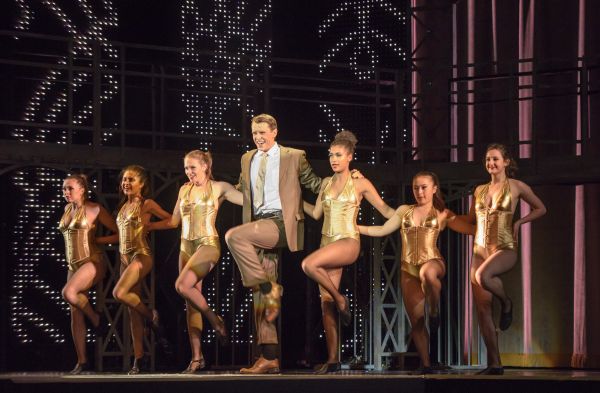Set in the mid-1920s, Broadway favorite Chicago follows the story of budding star Roxie Hart and veteran performer Velma Kelly as they vie for the spotlight in search of the American Dream: fame, fortune and acquittal from their death row convictions. According to Gabe Wieder, director and co-choreographer of the Ram’s Head production of the musical, “Chicago’s portrayal of a corrupt America, including its censure of gun violence and denunciation of the media’s fascination with women and sexuality, ring even more true today than ever.”
Five cast and crew members of Chicago, presented by the student-run theatrical society Ram’s Head, reflect on putting their latest show together – the commitment, the rewards, the return of the wall from previous shows – and share their thoughts about opening night.
The show goes on with final performances of Chicago on April 19, 20 and 21, 8 p.m. in Memorial Auditorium.

Alejandra Aguilar, ’18
The wall returns
“I helped build the video wall we are using in Chicago during my freshman year, when I was the sound designer for Hairspray! I’m thrilled to bookend my theater career at Stanford with this phenomenal project. It’s been exciting to see the wall evolve over the years and to see a new generation of theater lovers take ownership of the project.”
Opening night
“One truly beautiful moment for me was my experience throughout the first number on opening night. Seeing the cast on stage, seeing the tech elements come together, feeling the electricity throughout the audience, and finally getting to appreciate how every aspect of this show and of this process led to this moment – I was entirely overwhelmed. When the applause roared at the end of the number, the famous ‘All That Jazz,’ I was filled with joy and love for the show and for the company, and every moment of the past eleven months, the highs and the lows, felt completely worth it.”

Isabela Lim Angus, ’20
Character development
“It was exhausting, but so rewarding, to connect with a character as confident and strong, though twisted, as Velma. It was definitely a battle of self-confidence, trying to channel the kind of stillness and strength required to portray her even in her most desperate moments. The media’s sensationalism that creates characters out of real people is a huge theme in this show. This production really hits that theme on the nose and showcases how manipulated stories are fed to us, as readers, viewers and consumers, in order to further an agenda.”
Opening night
“Nothing will beat climbing out of the trap door in the stage for the very first time on opening night. Besides the band, the house was silent, as if we were all holding our breath, ready for the show to really begin. At that moment, standing beneath the stage, it hit me that my only job for the next two hours as Velma Kelly was to give the audience as much of myself as possible. The audience, this pitch-black and faceless entity, demands to be entertained. After months of rehearsals and work sessions, as a company, all we have to offer is an incredible piece of theater. We will continue to give them just that.”

Ayoade Balogun, ’21
First, first
“Chicago is my first show with Ram’s Head, and as I’m a freshman, it’s also my first show at Stanford. I was incredibly excited to sign on to the project because the show’s lively jazz and clever lyrics already had a special place in my heart. From my standpoint as music director I knew the music would be technically challenging, but our orchestra is so talented and committed. We’ve brought the score to life in a way that I couldn’t have anticipated.”
Opening night
“On opening night in the middle of Act One, all the actors’ microphones went out all at once. We joked that that’s what you get when you open on Friday the 13th. For about a song and a half, there was no communication from the cast to me and the rest of the orchestra, as we’re positioned backstage and couldn’t hear their lines or their singing. This could have easily created a disaster. But the way that everyone, orchestra and tech and cast, handled it is really a testament to the talent and dedication that is working on this show. The idea of ‘the show must go on’ must have been in the back of all our minds as tech worked to solve the issue while those performing kept moving forward. Thanks to our focus in rehearsals and our amazing folks on tech, the orchestra and the cast were able to stay together despite the technical issue, I think because we all knew our parts so well. It was hilarious to go out into the audience afterward and ask friends what they thought, and to realize that many didn’t notice! In terms of treasured moments, now that we’ve all done the show several times over, I find that I’m able to notice beautiful intricacies in the music that I hadn’t noticed before, and am loving the experience of hearing the audience react so warmly and excitedly to what’s going on onstage and in the music. I am so grateful to be a part of such a special production.”

Stephen Hitchcock, ’18
Art and technology
“As a senior who has worked on over 16 productions during my time at Stanford, I think the most exciting part of this experience was seeing the technologies I’ve been developing at Stanford coming together in a really exciting, synergistic way. Our show combines advanced lighting, video and automation technologies – each separately developed for the last three years of Ram’s Head shows such as Hairspray!, Rent and The Wild Party – to create a completely unique show-going experience. We are reusing the LED video wall and some of the automation technologies we worked on in 2016. I was a freshman in 2015 and helped design, then build the video wall. Since, we’ve been working on incremental improvements to help make the experience behind the scenes seamless for designers. It’s been really cool to bookend my Stanford experience with this video wall, and see all the ways I have grown as both an artist and a technician over the past four years.”
Dress rehearsal
“It wasn’t until our first dress rehearsal that I got to see the set, video and automation all working together cohesively. I know that I audibly gasped when the video wall first spun into view during ‘All That Jazz,’ and it is a memory I will treasure for as long as I continue to do theater.”

Gabe Wieder, ’20
Tricky and provocative
“The tricky thing is, Chicago is provocative by nature. The show was written to be a critique of American culture to the utmost degree, and naturally even after we chose the show, there has been a lot of struggles with what we can and can’t show on stage, and what Stanford audiences are able to handle. These conversations were personally some of the hardest that I had to deal with during the process, especially when it came down to changes in my artistic vision. I think we really encapsulated what Chicago can be in this modern time. I chose specifically to go against the revival version of minimalist, all-black costume, ‘fake’/Brechtian characters, in favor of a more fleshed out embodiment of the characters. This was actually closer to the way it was done originally than to the revival.”
Artistic vision
“My vision was to create two worlds: one of reality and one of fame, celebrity and performance. Being able to flip between them was critical, which is why the set has a transformative aspect where the LED light walls are actually part of giant rotating columns, which then spin around and light up during the musical numbers and turn into a brick facade during the scenes. This is specifically tied to Roxie’s storyline. The light wall is first revealed only when she fires the gunshots to kill her lover, and she officially becomes a murderess. It means that her way of dealing with the trauma of what she has done is to create this performative world.”
Billy Flynn (Sam Roach) makes a splashy intro

Photo by L.A. Cicero
The murderesses with Velma Kelly (Isabela Angus), center, sing about their crimes

Photo by L.A. Cicero
Chloe Wintersteen as Mary Sunshine performs “A Little Bit of Good”

Photo by L.A. Cicero
Amos Hart (Trey Hale) dances and sings “Mr. Cellophane”

Photo by L.A. Cicero
Roxie (Evie Johnson), in Billy’s (Sam Roach) care, meets the press

Photo by L.A. Cicero
Roxie Hart (Evie Johnson) describes her ambition in the eponymous song, “Roxie”

Photo by L.A. Cicero